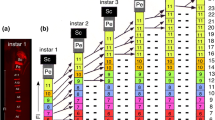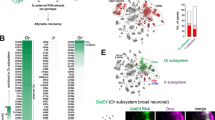Abstract.
A culture technique for the in vitro growth and differentiation of antennal cells of Mamestra brassicae is described. The morphology of the growing cells is described. At least five morphological cell types can be distinguished in the cultures. Neuronal cells (type A) were characterized morphologically and immunocytochemically with anti-HRP staining and could be separated into two subtypes, A1 and A2, on the basis of the size of the cell body. Non-neuronal cells could be divided into four types. Type-B cells consisted of large and flat cells with a veil-like cytoplasm. They usually adhered to each other and formed groups of 20 to 50 cells. Type C were large and flat cells, highly variable in size and shape. They closely resembled insect glial cells in culture. Type-D cells grew thick processes, up to 100 μm long. These elongated processes resembled trichoid hairs, and D cells are most probably trichogen cells. Type E were spindle-shaped cells present in low number in the cultures. A high proportion of similar cells in the hemolymph of pupae suggests that E cells are hemocytes. Pheromone-binding proteins were detected using specific antisera in the medium of 3- to 4-week-old cultures.
Similar content being viewed by others
Author information
Authors and Affiliations
Additional information
Received: 10 August 1996 / Accepted: 1 November 1996
Rights and permissions
About this article
Cite this article
Lucas, P., Meillour, PL. Primary culture of antennal cells of Mamestra brassicae: morphology of cell types and evidence for biosynthesis of pheromone-binding proteins in vitro. Cell Tissue Res 289, 375–382 (1997). https://doi.org/10.1007/s004410050884
Issue Date:
DOI: https://doi.org/10.1007/s004410050884




